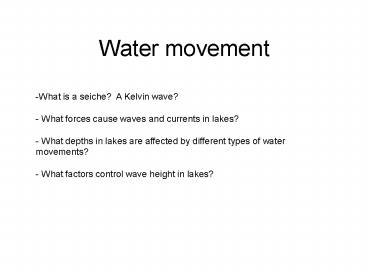Water movement PowerPoint PPT Presentation
1 / 26
Title: Water movement
1
Water movement
- What is a seiche? A Kelvin wave?
- What forces cause waves and currents in lakes?
- What depths in lakes are affected by different
types of water movements? - What factors control wave height in lakes?
2
Energy sources Wind
- Wind drives waves and currents
- Energy transfer ? Wind speed, fetch, duration
- Energy of water movement ? ?
3
Long Standing Waves (seiches)
4
Surface Seiches
Wind Wind Stops
5
Large, Destructive Seiche, Lake Michigan, 1954
Small Seiche, L. Superior
6
Lake Ontario internal wave
Ontario surface seiche of 1m
7
Thermocline depression can be 10-100 times
surface seiche amplitude
Wind
Water column mass ?surface H1 ?hypolim
H2
H1 H2
- Thermocline depression
- (Hsurface x ?hypolim) / (?hypolim - ?epilim)
8
(No Transcript)
9
Effect of Water Movements on Plankton
Upwelling
10
Kelvin Wave
Coriolis force balances gravity acting on surface
height of basin-scale wave
Gravity
Coriolis
11
Coriolis Force
v
- Conservation of angular momentum
- m1r1v1 m2r2v2
- If r decreases (while moving toward pole), v
increases (in direction of rotation)
m
r
12
Surface kelvin waves
- Basin gt 15 km
- Coastally-trapped
- seich return
- counterclockwise
- coastal wave
13
Surface waves
- Wave energy transferred to depth
- Water velocity becomes neglible at ? /2
- Water depth lt ? /2, erosion
14
Shallow-water wave
15
Surface waves
- Controls on h
- Fetch
- Windspeed
- Water Density
- Water Depth
16
(No Transcript)
17
Lake Surface Currents
- Forced by wind, inflow, density gradients
- Directional flow horizontal and/or vertical
- Can be affected by Coriolis force
18
Winds and Currents
19
Langmuir Currents and Streaks
- Langmuir convergence/ divergence affects
distribution of stuff - High wind speeds disrupt streaks
20
Langmuir currents
Helical currents from wind above 3 m/s Helical
cells can extend to thermocline
21
Currents from inflows
22
Thermal resistance to mixing and stability
23
The Richardson Number
- Determines whether or not two fluids will mix
- Ratio of buoyancy (gravity-driven forces) to
kinetic energy - Ri(gd?/dz)/(?ave(dU/dz)2
- gacceleration of gravity ? is density U is
horizontal water current speed
24
Schmidt Stability
Work required to instantaneously completely mix a
lake
?
V1, A1, ?1
?ave
Zave, Aave, ?ave
V25, A25, ?25
25
Wedderburn Number
- Integrates density/energy gradients with lake
morphology influences - W (H2g)/(Lµ2)
- H mixed layer depth
- g change in gravity due to density change at
pycnocline - g 1000g(?h - ?e)/(?ave) 9.8(?h - ?e)/(?ave
) - L Fetch
- µ2 (0.00123)CDUw2
- CD 0.0013 for large lakes, 0.001 for small
lakes - Uw wind speed in m/s
26
Summary
Wind-driven turbulence Waves, currents, langmuir
Seiches and kelvin waves
Density flows
- Turbulence that mixes surface layer from
wind-driven water movements - Turbulent energy dissipated by friction in
water, on bottom, on thermocline - Internal seiches and currents can affect bottom
of lake below surface mixed layer

